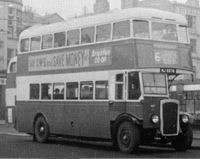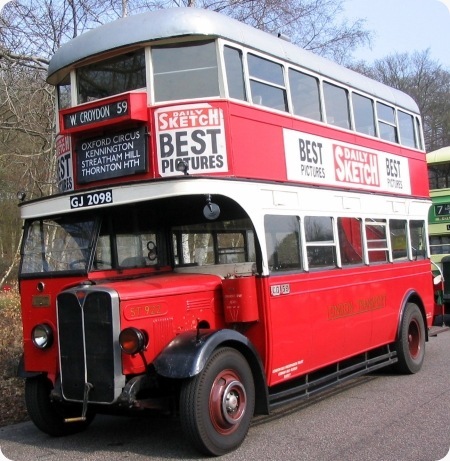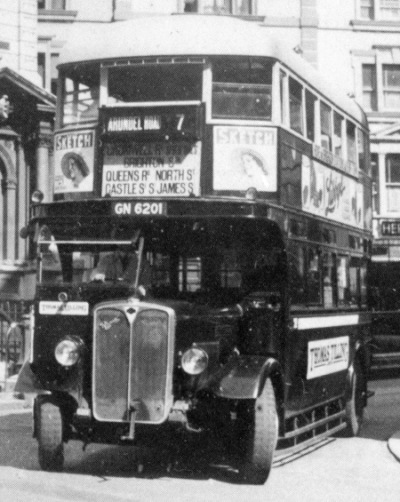Brighton, Hove & District - Dennis Lance II - NJ 5978 - 6315
Brighton, Hove & District
1935
Dennis Lance II
Tilling H30/26R
Not a big user of the marque, Thomas Tilling, nevertheless, for Brighton town services, bought four
Dennis Darts, then two Dennis Aces between 1932 and 1934.
In 1935, they then bought six Dennis
Lance II’s, adding Tilling bodywork in the style of their 80 London STL cousins. Here is 6315, standing,
driver’s door ajar, at Brighton Station, not long after the war. It is blinded for Fishersgate
(Portslade).
Unlike its London cousins, it shows no trace of body sag! The radiator has the style
of those fitted to the sweet little Dennis Darts of the early 1930’s and not the ‘Dutch Roof’ design,
thick or thin, that had DENNIS across the radiator centre. This one has a small DENNIS plate below the
radiator cap. Although it has the archaic triple window front upstairs, the larger BH&D blind box suits
this front more than the ‘pinched’ LT style did. One change is that the rear upstairs emergency exit
does not have twin windows that its London cousins possessed. All six were withdrawn in 1949.
Photograph and Copy contributed by Chris Hebbron
27/08/12 - 20:07
As at 3.35pm on Monday, I find nobody has yet had a comment published about
this. Surely, you’ve not left us all speechless, Mr Hebbron??? (More likely, of course, that Peter
hasn’t had chance to post the comments made already.)
I’ve seen a few buses with the triple
front windscreen arrangement, and they seem to have been London types for the most part, with a few
CIE vehicles as makeweight. I can understand that the London ones may have fallen under the
influence of the Metropolitan Police, but what about CIE? Did they simply like the design and stick
with it for many years?
Pete Davies
27/08/12 - 20:11
Chris. Many thanks for the super photo of a BH&D Dennis Lance. It was news to me that they had any Lances, which were very uncommon in Tilling controlled fleets, as I can only think of the 1936 pair at Southern Vectis, with the later radiator. Perhaps this was due to Dennis persevering with the 4 cyl. notion of a double deck chassis, which most had, I believe, in petrol and/or 04 (Lanova ?) form.
Dennis had supplied the Tilling group with substantial numbers of petrol
engined Lancet 1 single deckers, and the standard small bus was the Ace, but with the advent of
Bristols in the group,Dennis were keen to protect this business. Consequently, trial batches of
Lancet 2s , with 04, or 5LW engines, were supplied, but as far as I can see, the only fleet to take
any real number was Caledonian. What engines did these Lances have, and when did BH&D start to
convert their AECs to oil engines?
Indeed, when were their first Bristol Gs or Ks delivered?
The Lances lasted well, did n`t they, especially as they were not so different from the London
collection (DL class) which were all gone by about 1937, albeit a year or two older.
More
detail of the Brighton fleet up to 1950 would make delightful reading!
The Lances of the later
1930s, as supplied to Walsall, and Merthyr, had very compact cabs because of their short 4 cyl.
engines, theoretically enabling more effective use of passenger space, a bit like the Daimler
COG5/40 concept. Fascinating stuff!
John Whitaker
27/08/12 - 20:16
These Brighton, Hove and District Lances were numbered 6311 to 6316, registrations NJ 5974 to 5979. The bus in the picture would appear to be 6315, NJ 5978. The pre war Lance never used the heavy style of radiator of the Lancet I, but the version used on these BH&D Lances appears to have been a slight variation upon the usual contemporary pattern which had a tapering grille set within a parallel sided frame, the bottom edge of which formed a shallow "V". Other Lance IIs, notably those of Aldershot and District, used the high set oval radiator of the Lancet II (and later III) which resulted in a decidedly restricted view from the cab. The Tilling bodies on three of the BH&D Lances, 6311/4/6, were rebuilt by Portsmouth Aviation in 1947, which made their withdrawal just two years later seem rather a profligate decision. I cannot establish if these Lances were powered by the 6.1 litre 100 bhp 6 cylinder ohv petrol engine or the 6.5 litre 85 bhp sixteen valve 4 cylinder O4 diesel, though, in view of the severe gradients in parts of the Brighton area, the petrol version would have been more likely.
Roger Cox
28/08/12 - 18:01
I don’t think that the three-window design would have been anything to do with
the Metropolitan Police regulations. It’s notable that the LGOC effectively abandoned three windows
around 1930 and all their Regents and Renowns had two windows, whereas Tilling and many of the
independents continued to have three windows.
I suspect that it had more to do with the need
on buses without roller blinds for a large opening window for the conductor to lean out of to change
the destination boards. By the time the Tilling STLs came out I suspect it was just a styling
hangover.
Michael Wadman
30/08/12 - 11:49
It is good that BH&D has been given an airing thanks to Chris H. 6315 was one of a batch of six Dennis Lances that were operated by BH&D and were the last petrol-engined double decker buses to join the fleet. They were converted to diesel as follows: - 6312, 6313, 6315, 6316 received Gardner 5LW engines between 1942 and 1946 and 6311,6314 were fitted with AEC 7.7 engines and radiators. When withdrawn in 1949, they were all sold to Westcliff-on -Sea Motor Services Ltd for further service. I do hope we will see more BH&D buses on this web site soon.
Richard Fieldhouse
31/08/12 - 07:29
The three window design for the upper deck was also used on pre war trolleybuses in Huddersfield Indeed a batch of Park Royal Sunbeams of 1949 also had this styling.
Chris Hough
31/08/12 - 07:30
Thx, Richard, for the additional info.
If the condition of these
vehicles is as good as seen in the photo, plus diesel engines, I’m not surprised that they were sold
on for further service, Richard. Wonder when they finally went for scrap?
Strange that they
were re-engined with two types of engine. The fitting of AEC radiators to 6311 and 6314 was an
unusual move. I wonder if changing petrol engines for diesels was a common action in the war. I’m
not aware that it was.
Chris Hebbron
31/08/12 - 09:42
I was surprised to learn about the Gardner 5LW engine changes in the war period as I believe these were in very short supply and tightly regulated by the Ministry of War Supply. The Daimler Company had only a limited supply of 5LW engines for their production of the CWG5 model in 1943. I can only assume BH&D may have had a few 5LW engines in stock. I have no knowledge about the Dennis Lance operation in Westcliff but I believe the AEC engined Dennis Lances were converted to open top, so possibly ran for some time into the mid-fifties. However another related war time matter that has always been hard to understand is how BH&D could store 7 new AEC 661T/Weymann trolleybuses from 1940 to 1946 when other towns and cities were in desperate need for trolleybuses. Brighton Corporation AEC 661T/Weymann trolleybuses were loaned to Newcastle during the war.
Richard Fieldhouse
04/09/12 - 08:44
Another operator of buses with three windows at the front of the upper deck was Luton Corporation, who operated some pre-war Daimler COG’s with Willowbrook lowbridge bodywork thus fitted. A picture appears on this very site! (see Luton Corporation). A brief look at a fleet book I have reveals Luton operated several Daimlers of CH6, CP6 (petrol), and COG5 (diesel) types, all with Willowbrook L26/26R bodies. These had the lowbridge gangway on both nearside and offside, and were new from c.1933 to 1938, most surviving into post-war years, being withdrawn c.1948-1953. I believe the use of the double lowbridge gangway was originally used to avoid the patent payment to Leyland for their 1927 design, but I think that this was cleared by c.1933/34, so it’s continued use after that date must be operator preference / standardisation. Presumably the three-window upstairs layout suited the two-gangway/central seating block layout inside.
Michael Hampton
18/04/13 - 07:05
Just to keep the record straight the SIX Southern Vectis Dennis ‘Lance’ double deckers delivered in 1935 had Gardner 5LW diesel engines from new.
Patrick Hall
30/07/13 - 15:37
The six Lances [600-605] ADL 500-505 for Southern Vectis were delivered in
1936 with 600/1 arriving 29/5/36 and 602-5 arriving -/6/36.
They had a hard life with SV
especially during the war years but still managed to give 17 years service [600/2/4] or 18 years
[601/3/5], so the last ones were still in use as spare buses when the first Lodekkas arrived!
Apparently [604] survived with a Showman in Gloucester until November 1965.
Any further
news/photos of them welcome.
Vectis83
31/07/13 - 07:51
Here, at least, are a couple of photos of them:
Here’s a photo, behind
the T-S, of 500 in pre-war livery (and large SV lettering) - See (scroll): //tinyurl.com/klbxrz7
Here’s a late photo of 504 - See (scroll down): //tinyurl.com/oe358ku
Chris Hebbron
31/01/14 - 10:12
First of all a correction to a commonly made mistake - the company to which
the BH&D Lances went was Westcliff-on-Sea Motor Services NOT WestcliffE …
Of the six
Lances one, NJ 5976 was converted to open top (I think by Westcliff, not by BH&D) and used on the
Southend sea front services. The others were used mainly(possibly entirely) on contract work. One
later finished up as a store at Southend depot. Several later acquired AEC radiators. None received
Eastern Nation fleet numbers in July 1954, so they must all have gone by then. I think (but cannot
check, as I cannot locate my copy) the recent history of Westcliff has a photo of one with that
company.
Brian Pask
Thanks Brian I have corrected the spelling of Westcliff.
02/05/14 - 17:55
Further to my query posted above in August 2012, about how BH&D could store their new AEC661T/Weymann trolleybuses throughout the period 1939 to 1945, perhaps some correspondence from the LPTB to the BH&D Tilling Group may put some light on the matter. Michael Dryhurst has written a most interesting "What if-" article in "Classic Bus" no.130 April/May 2014 on these stored BH&D trolleybuses. It would seem the LPTB would have liked to purchase these BH&D trolleybuses in 1944 for use on their 654 Crystal Palace to Sutton route to relieve serious vehicle shortages due to serious war damage to Bexleyheath and West Ham depots.
Richard Fieldhouse
03/05/14 - 07:19
Richard highlights one of the most intriguing episodes of WW2 transport
history here. Why were these vehicles stored throughout the war when there were chronic shortages
all over the country?
I too have seen the article in "Classic Bus", which is a
fascinating "what if" scenario, especially as the B.H.and D. 661Ts had coasting and run
back brakes, making them eminently suitable for LPTB.
Perhaps the answer lies in their
Crompton Parkinson equipments, totally non standard as far as London trolleybuses were concerned,
but thanks, Richard, for bringing up this point.
John Whitaker
03/05/14 - 07:20
I’ve just found out that Westcliff-on-Sea took delivery of three Dennis Lances
in 1931 (JN960/1/2), so there was a logic in their taking the BH&D ones. Incidentally, these also
finished up with AEC radiators.
Interesting about LPTB’s bid to buy BH&D’s trolleys. Obviously
LPTB got by with their shortage in the end, since the only trolleys they ever borrowed were some
Bournemouth ones earlier in the war to cover a shortage overcome by acquiring the South
Africa-destined trolleys in the end.
Chris Hebbron
 Vehicle reminder shot for this posting
Vehicle reminder shot for this posting
19/01/15 - 07:25
On 31/01/14, Brian Pask mentioned that the six Lances went to Westcliff-on-Sea, five to contract work. Here’s a photo of Brian’s, showing NJ 5979 doing this work. The front blind area has changed and the front has also been modified to achieve double windows upstairs. The cab windscreen’s also been altered to allow for the AEC radiator. It’s not an improvement on an otherwise fairly streamlined original front. www.sct61.org.uk/wmnj5979
Chris Hebbron
Quick links to the - Comments Page - Contact Page - Home Page




